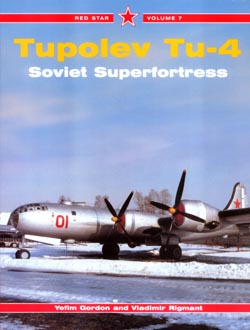 Tupolev Tu-4 Superfortress Tupolev Tu-4 Superfortress
Red Star Volume 7
By Yefim Gordon and Vladimir Rigmant
Midland Publishing, 2002
ISBN 1-85780-142-3
Softbound, 128 Pages
Available from Specialty Press for $27.95 The idea that Soviet aircraft designers merely copy Western designs got plenty of fuel with the Tupolev Tu-4. There is no doubt whatsoever that the Tu-4 was a copy of the Boeing B-29 Superfortress, as interned US B-29s formed the patterns for the Tu-4. But what is not as well known is that it was not a direct copy, as Tupolev made some small improvements to the type. This book covers in great detail the development of the Tu-4 and the industry surrounding it, and shows how this one plane significantly shifted the manufacturing capabilities of the Soviet Union to be more in line with Western technology. The fascinating text is accompanied by plenty of photos, showing the original US aircraft both on arrival and in factories undergoing disassembly. There are also lots of photos of operational Tu-4s, code-named Bull by NATO. The operational Tu-4s were pretty basic, though, with little more than stars and numbers for markings on their natural metal surfaces. As the book progresses past the development stage, it turns to some of the different variants of the Tu-4. Included here are the Tu-4K missile carriers, the Tu-4T transport/troopship, the Tu-4R long-range reconnaissance aircraft, and the Project Burlaki aircraft. This last one was an escort fighter mother ship concept where a converted Tu-4 would tow a MiG-15 behind it, providing fuel to the fighter and extending its range to match that of the regular bomber version of the Tu-4. While tests showed the system had some merit, the introduction of jet bombers like the Tu-16, and the introduction of aerial refueling, made the concept obsolete. The rest of the book deals with follow-on projects of the Tu-4, as well as Chinese usage. The later projects developed from the Tu-4 built upon the solid performance of the type, but did not resemble the original much. These aircraft, the Tu-80 and Tu-85, were larger and had a much greater performance than the Tu-4 had, but compared to jet bombers entering service at roughly the same time, there was no contest. The designs are interesting, though, and this book does a good job of covering them in some detail. Overall, this is easily the best English-language book on the Tu-4 and is recommended to anyone who is interested in Soviet bomber technology. Likewise, if you are in to the B-29, this is definitely a book you should not pass up. My thanks to Specialty Press for the review sample. You can get this, and other Red Star titles, from their website. A shipping and handling charge of $4.95 is applied to each order. | 









|